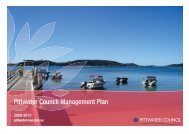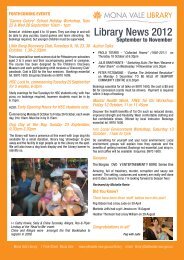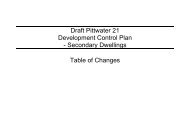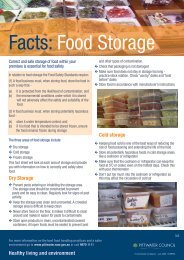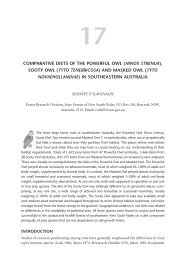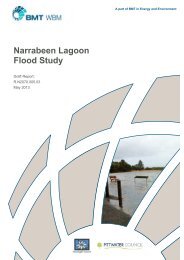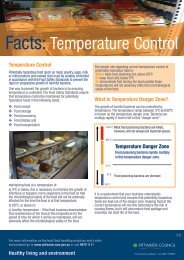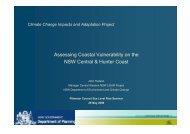Brief History of Narrabeen Lagoon - Pittwater Council - NSW ...
Brief History of Narrabeen Lagoon - Pittwater Council - NSW ...
Brief History of Narrabeen Lagoon - Pittwater Council - NSW ...
You also want an ePaper? Increase the reach of your titles
YUMPU automatically turns print PDFs into web optimized ePapers that Google loves.
Local history from Captain Cook to current days... 6-11<br />
•<br />
•<br />
•<br />
•<br />
•<br />
•<br />
•<br />
•<br />
•<br />
•<br />
•<br />
•<br />
•<br />
•<br />
•<br />
•<br />
•<br />
•<br />
•<br />
•<br />
•<br />
•<br />
•<br />
•<br />
•<br />
•<br />
•<br />
•<br />
1770 Captain Cook’s Log notes “some broken land that appeared to form a bay” 6<br />
1788 The first <strong>of</strong>ficial European to visit, Governor Philip, describes it as a large lake surrounded by a bog &<br />
large marsh, taking 3 days to walk around the lagoon. 6<br />
1801 Local Aboriginals describe the stream at the lagoon entrance as ‘Narrowbine’ to Lt James Grant, as he<br />
leads a search party north. The entrance was about100m wide. 6<br />
1814 James Meehan surveys the area using the name ‘Narrabang lagoon’, then 1830 William Govett uses<br />
‘Narrabine <strong>Lagoon</strong>’. First land grants in 1815, 1816 and 1823. 10d<br />
1861 Bridge built across Dee Why lagoon, as settlements spread north.<br />
1883 First bridge built across <strong>Narrabeen</strong> lagoon at <strong>Pittwater</strong> Rd (not 1884 as previously thought). 10d<br />
Late 1800s Drilling in Deep Creek area for coal, gas & petroleum. No commercial deposits found. 12<br />
1897 <strong>Narrabeen</strong> Post <strong>of</strong>fice services 30 local residents, mostly farming families.<br />
1911 <strong>Lagoon</strong> dredging starts, mostly in Eastern channel & around Wimbledon Avenue area. 11<br />
1912 The area has 115 residents, 8 grocery shops, 5 boarding houses, 2 butchers.<br />
1913 The tram service extends to <strong>Narrabeen</strong>, the “end <strong>of</strong> the line”, bringing visitors to the Lakeside camp<br />
site. 1924 Spit Bridge opens, starting a boom in day-trippers.<br />
1924-28 Drought. 1925 Ocean St bridge is built by Arthur Larkin. Dry lagoon bed is used for motorbike and<br />
car races, as well as biplane flights for 10 shillings.<br />
1920s-30s Lime company at Deep Creek extracts lime from shells in middens & sediments. 12<br />
1930s Depression: homeless live in campsites at North <strong>Narrabeen</strong> and Deep Creek. German seamans camp<br />
at Deep Creek marked by rock engravings <strong>of</strong> swastikas & ship names. 12<br />
1940s Major storms and floods in the <strong>Narrabeen</strong> area. Urban development spreads. Wakehurst Parkway and<br />
western bridges built in the war years & opened in 1946.<br />
Post war: A boom period <strong>of</strong> broad-scale development & population growth. Improved access, transport &<br />
rise <strong>of</strong> the family car brings more day-trippers. Large fleets <strong>of</strong> 12ft & 16ft sailing skiffs raced in the lagoon<br />
waters, until the late 1950s. 6<br />
1950s & 60s Dredging in central basin. 11 1954 the deteriorated <strong>Pittwater</strong> Rd bridge is replaced. 9<br />
1960s & 1970s Rapid suburban development. Mid 1960s began regular mechanical opening <strong>of</strong> the<br />
entrance to reduce flooding to new low lying houses. 11 Conservation groups mount increasing pressure for<br />
protection <strong>of</strong> natural areas in the catchment.<br />
1970 Clean Waters Act restricts activities that affect water quality, eg. dredging.<br />
1974 Legal protection to large areas with minimum subdivision 5 acre (IDO51). 10a Birdwood Park high dunes<br />
constructed to reduce wind-blown sand blocking the lagoon entrance. 11<br />
1977 <strong>Narrabeen</strong> <strong>Lagoon</strong> Committee established, an active community group for nearly 30 years. 10b<br />
1982 Rock wall built on north side <strong>of</strong> lagoon entrance to direct & assist flows. 11<br />
1990s & on: Urban sprawl into Belrose, Oxford Falls, Red Hill, Cromer Heights, Collaroy Plateau &<br />
Warriewood. 1991 part <strong>of</strong> Deep Creek catchment added to Garigal National Park.<br />
1991 Coastal Environment Centre established on the northern foreshore <strong>of</strong> the lagoon.<br />
1994 <strong>Pittwater</strong> Natural Heritage Association established to protect local environment. 10c Major bushfire<br />
burns large tracts <strong>of</strong> bushland in catchment, some houses lost.<br />
1996 Warriewood Wetlands purchased by <strong>Pittwater</strong> <strong>Council</strong> from private ownership.<br />
2005 Friends <strong>of</strong> <strong>Narrabeen</strong> <strong>Lagoon</strong> Catchment replaces <strong>Narrabeen</strong> <strong>Lagoon</strong> Committee. Lobbies local and<br />
State governments to address threats to the lagoon & catchment.<br />
2007 <strong>NSW</strong> government grants $1.9m for rehabilitation <strong>of</strong> the lagoon & creeks, in a joint 3-year project with<br />
Warringah & <strong>Pittwater</strong> <strong>Council</strong>s, including community education.<br />
<strong>Narrabeen</strong> <strong>Lagoon</strong> a brief history<br />
Sustainable living for thousands <strong>of</strong> years<br />
The name ‘<strong>Narrabeen</strong>’ may have come from the Aboriginal ‘Narrabang’ (wild swan) or Narrowbine’<br />
(the lagoon entrance). 2 The lagoon was <strong>of</strong> great significance to the indigenous ‘saltwater people’ <strong>of</strong> the<br />
Guringai, who depended on the abundant food sources <strong>of</strong> the area and had strong connections to the<br />
coast, flora and fauna. 1 The Black Swan inspired their culture as a totem.<br />
The Guringai inhabited the wider region for some 20,000 years, 2 though their area would have<br />
contracted about 6500 years ago as the sea levels rose, flooding a 20km wide strip <strong>of</strong> coast and<br />
forming the coastal lagoons. There were 3 main family groups, interacting for trade and ceremonial<br />
occasions. The frequented ‘Coastal Dreaming Track’ was roughly aligned with <strong>Pittwater</strong> Rd and linked<br />
with tracks to Ku-ring-gai, Middle Harbour, Manly and the cultural icon <strong>of</strong> North Head. 1<br />
The Guringai were very resourceful, living according to the seasons. Summers were spent<br />
harvesting seafood, with campsites at Middle Creek (Sport Academy site) and Mactier St <strong>Narrabeen</strong>.<br />
Local sites for food collection or ceremonies included the lagoon and entrance, beach, rock platform,<br />
<strong>Narrabeen</strong> Head, Cromer and Elanora Heights, Deep Creek, as well as ocean fishing using canoes.<br />
Beach dunes were high, broken by a few ancient walkways and had many shellfish middens. Winter<br />
was <strong>of</strong>ten spent inland (eg. Middle Harbour, Roseville) harvesting bush foods and hunting land mammals.<br />
‘A rich variety <strong>of</strong> bush tucker’ 13<br />
Warrigal Spinach - a bush food from the lagoon foreshores<br />
Familiar with the times <strong>of</strong> breeding, migration, flowering and fruiting, they would harvest and encourage<br />
their favoured foods to flourish as sustainable supplies:<br />
• Coastal lagoons were a cultural focus, and a source <strong>of</strong> food and fibre from plants, birds, reptiles,<br />
mammals, fish, shellfish and prawns. 1 Many rock engravings exist in key protected sites <strong>of</strong> the<br />
catchment, <strong>of</strong>ten depicting hunting scenes. 3,4<br />
• Plants for food, nectar, dyes & tools included Banksia, Dianella lily, grass trees, Lillypilly,<br />
Cabbage Tree Palms, grasses & yams. Smouldering Banksia cones were used as fire coals. 1<br />
Cooking and even flesh wounds could be wrapped in Paperbark.
• Nothing was wasted. Teeth, bones, quills, feathers, claws, shells and rock were used for decorations<br />
or tools for sewing, fishing, cutting, harvesting or sharpening spear tips. Animal skins were used for<br />
winter warmth, sleeping mats or baby slings. Surplus dyes, shells, hooks and salt were traded widely. 1<br />
• Food production by firestick farming, horticulture and animal management practices helped<br />
sustain food sources such as emus. Fish farming included oyster farming, fish traps and<br />
cages, even using dolphins to herd fish for capture (eg. mullet and tailor). Bird rookeries, as<br />
egg sources, were actively protected from predators such as dingoes and spotted cats. Overharvesting<br />
was prevented by strong codes <strong>of</strong> punishment for taking more than was needed.<br />
Only a select few could eat fish roe or bird eggs. Large fish were not to be taken, as these<br />
female or elder fish sustain the fish population and teach migration routes to their young. 3<br />
Some 100 years later, even with many land grants and farms, it was still renowned for its natural beauty<br />
and wildlife - popular with day trippers for boating, bathing and picnics, especially at Deep Creek up to<br />
the 1930’s. With the advent <strong>of</strong> bridges, trams, then roads and cars the area was rapidly developed.<br />
With European contact, much <strong>of</strong> the local population died from disease or were<br />
1925 - Ocean Street Bridge Construction 1930s - Living in <strong>Narrabeen</strong> Campground<br />
forced away. A tragic loss <strong>of</strong> elders, knowledge and culture resulted. Local communities<br />
and the Aboriginal Heritage Office now help safeguard Guringai culture and<br />
heritage, which is celebrated annually at the Guringai Festival.<br />
‘Respect and understanding was shown for the source <strong>of</strong> food… conducive to<br />
the wellbeing <strong>of</strong> our food resources…leading to minimal environmental impact on<br />
the food chain and resulting in long-term sustainability <strong>of</strong> the food source.’ 3<br />
Europeans change the landscape<br />
‘Discovered’ in the late 1700s by Europeans, the lagoon had large seagrass meadows and extensive<br />
fringes <strong>of</strong> wetland, reeds and Sheoaks. Early accounts show that the lagoon was deeper than today,<br />
with clear waters, a sandy bed and abundant birds, fish and prawns able to support commercial fishing.<br />
The northern lagoon shore had ancient trees full <strong>of</strong> roosting birds at night – “egrets, cormorants,<br />
pelicans, thousands <strong>of</strong> [birds]…the noise was deafening... if [birds were] startled awake”. 3 T h e<br />
<strong>Narrabeen</strong> sand spit had thick groves <strong>of</strong> lillypilly and tall figs.<br />
“The popular charm <strong>of</strong> the upper waters will always be the creeks which penetrate far inland<br />
and receive the little rills and tinkling cataracts which in rainy seasons and flood-times roll<br />
down great torrents to the lake ...it is a delightful wilderness…... come out again upon<br />
the lake, all calm and sacred with the hush <strong>of</strong> late afternoon, to a little bay here smooth as<br />
glass… even the tall feathers upon the marginal reeds do not stir, and if there is any wind<br />
from the oaks above it is the s<strong>of</strong>test “whish”...<br />
Every line about it is absolutely beautiful, from the sky to the beach. The hills are l<strong>of</strong>ty…<br />
grand as beautiful upon any sunny day when upon the lowlands the honeysuckles twinkle<br />
and glisten… When all the rounded crowns <strong>of</strong> the gums are lit as masses <strong>of</strong> cumuli cloud by<br />
a mid-day sun, when ferns and undergrowth seem actually silver gilt with the magical effect<br />
<strong>of</strong> the light and air, when higher, wet rocks flash like jewel facets, and huge crag masses<br />
frown through a sparse and distorted growth, and cut the sky in bold or fantastic shape…<br />
Take advantage <strong>of</strong> it now as it is, for surely as human nature will seek to surround itself with<br />
natural beauty, it will become an outpost <strong>of</strong> the great city ‘ere long” Myers 1886 5<br />
1942 - <strong>Narrabeen</strong> Flood 1946 - Wakehurst Parkway Opening<br />
The timeline overleaf shows that within 200 years <strong>of</strong> Europeans<br />
arriving, they had dramatically changed the landscape and the lagoon’s<br />
ecology.<br />
Though much <strong>of</strong> its natural beauty still remains today, the health <strong>of</strong> the<br />
lagoon and its catchment are under threat from the impacts <strong>of</strong> urban<br />
development – we can each help protect it by learning about our local<br />
environment, helping restore it and reducing our impacts at home and<br />
beyond.<br />
Bank Stabilisation - <strong>Narrabeen</strong> <strong>Lagoon</strong><br />
References<br />
1. Lee, Emma (2002) The Tale <strong>of</strong> a Whale – significant Aboriginal landscapes <strong>of</strong> the northern beaches. Pp 62-70.<br />
Metropolitan Local Aboriginal Land <strong>Council</strong>. 994.4 LEE<br />
2. Jacobs, Ian (2003) A history <strong>of</strong> the Aboriginal clans <strong>of</strong> Sydney’s Northern Beaches. Northside Printing.<br />
3. Foley, Dennis (2001) Repossession <strong>of</strong> our spirit – traditional owners <strong>of</strong> northern Sydney. Pp 40-63. Aboriginal <strong>History</strong><br />
Inc., Canberra. 994.4 FOL<br />
4. Stanbury & Clegg (1990) A field guide to Aboriginal rock engravings. Oxford Uni. 994.4 STA<br />
5. Myers (1886) The Coastal Scenery <strong>of</strong> <strong>NSW</strong>. Excerpt on <strong>Narrabeen</strong> <strong>Lagoon</strong>. Passages quoted in 6.<br />
6. Dept Education (1991) Middle Creek Ecosystem Study. North Sydney Region, Geography.<br />
7. Lawrence, J (2006) Pictorial <strong>History</strong> <strong>Pittwater</strong>. Kingsclear. Pp 77-80. 994.4 LAW<br />
8. Sharpe, Alan (1983) Pictorial memories Manly to <strong>Pittwater</strong>. Atrand. 994.4 SHA<br />
9. RTA (2005) <strong>Narrabeen</strong> Lake Bridge. Heritage & Conservation register, RTA website<br />
10. Pers. Comm. a) David James, b) Phil Colman, c) Marita Macrae, d) Virginia Macleod (<strong>Pittwater</strong> Library)<br />
11.WBM Oceanics (2002) <strong>Narrabeen</strong> <strong>Lagoon</strong> Estuary Mgt Plan. For Warringah&<strong>Pittwater</strong> <strong>Council</strong>s.<br />
12. Morcombe, John (2008) article on Deep Creek history, Manly Daily 12/1/08.<br />
13. Photo: Botanic Gardens Trust. For information see www.rbsyd.nsw.gov.au<br />
Prepared by the CEC 2008. Indigeneous content approved by the Aboriginal Heritage Office.




